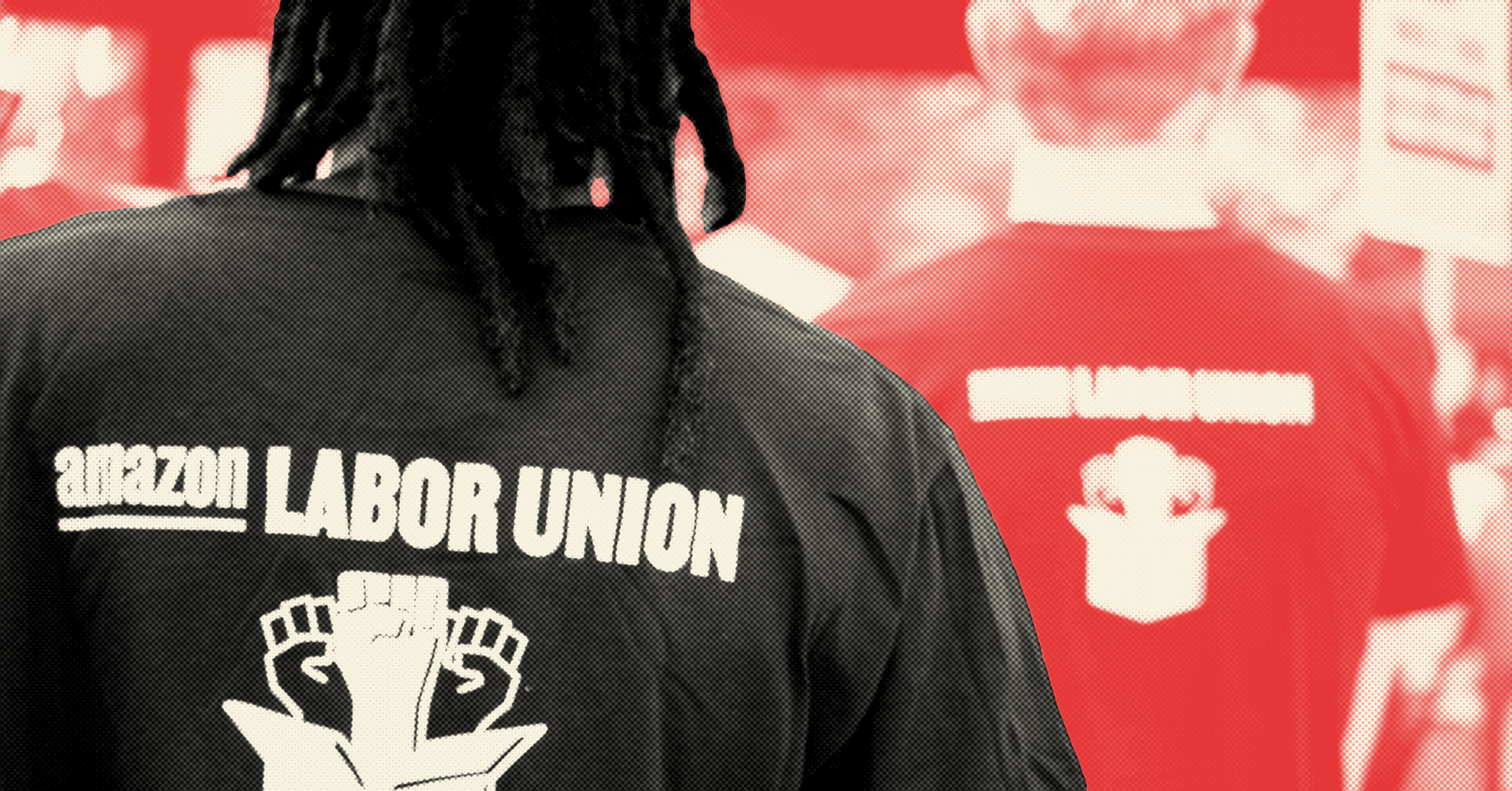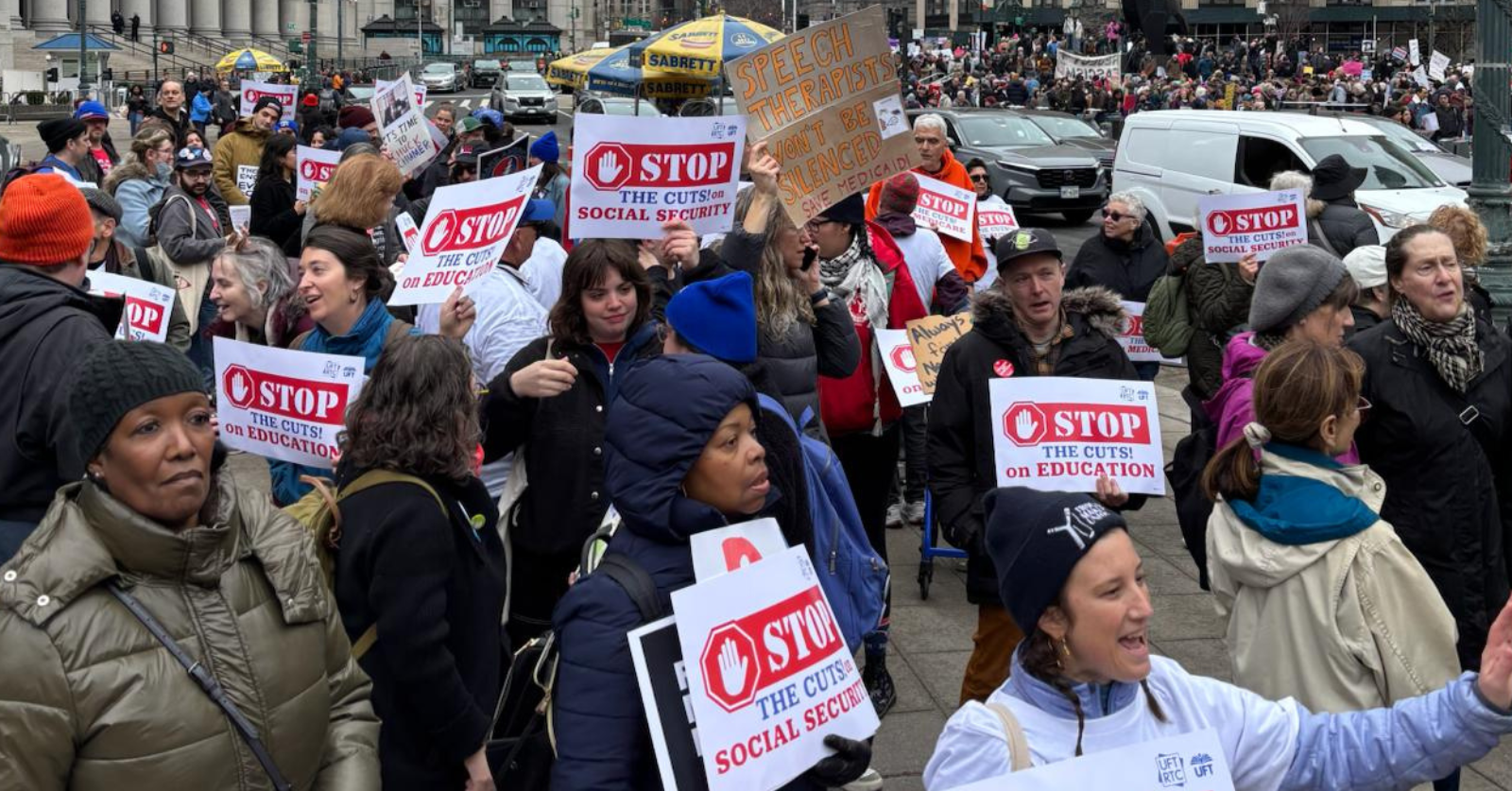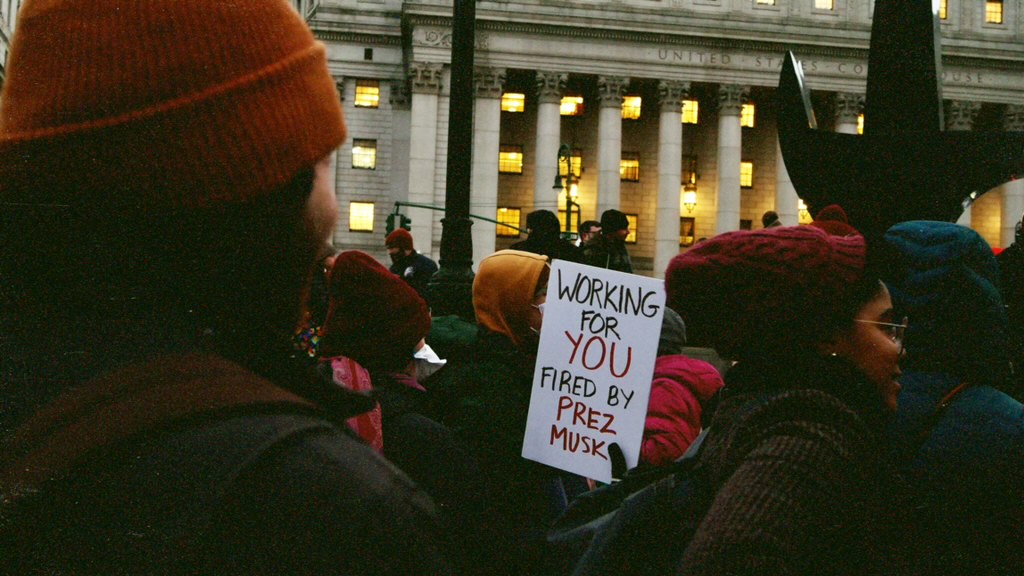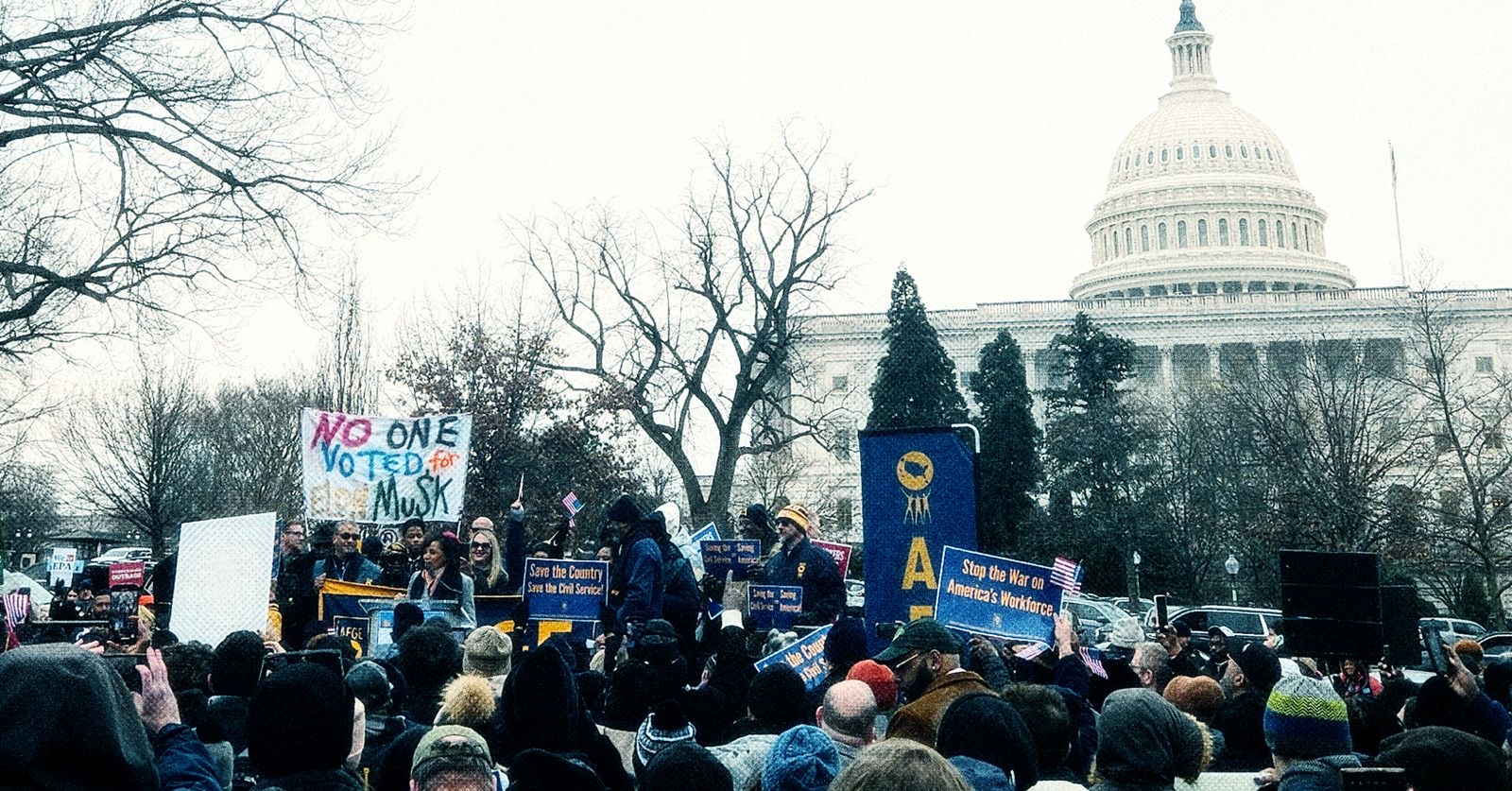For five decades the U.S. labor movement has been in decline, as employers crushed the working class under the boot of neoliberalism. Throughout this period, many unions suffered under business unionist leaders, who lacked the interest or vision to aggressively fight back. Unions were also beset on all sides by attacks from employers and lacked a strong enough Left-led militant minority, which historically has catalyzed the labor movement’s greatest successes. However, for several years the social and economic tectonic plates that our working lives invisibly rest upon have been shifting, and finally in spring 2022, we can say the working class might be starting to rise again. We can now imagine an earthquake that, if it comes to pass, will shake the world.
The greatest markers of this potential opening are the wave of hundreds of Starbucks stores unionizing across the country and the amazing success of the Amazon Labor Union in organizing an Amazon warehouse on Staten Island. ALU landed the first major blow against the second-largest private employer in the country — a company which is coming to play a determinant role in the crucially important logistics sector. The ALU win is so enormous, and was so unexpected by almost everyone on the Left and in the labor movement, that it calls for broader reflections on the conditions that have brought us to this point. These developments have also occurred alongside recent victories by reform movements in the UAW and the Teamsters, and victorious strikes by union workers in manufacturing, nursing, and teaching — developments that show that already unionized workers are also in motion. How did we get here, and where do we go from here?
This rising wave of worker militancy can be traced to three interwoven components: 1) pandemic economics, 2) the culmination of decades of slow, deep organizing by the militant minority, and 3) the rebirth of the socialist movement. The combination of these factors has led to a rapid increase in working-class consciousness, allowing ambitious new organizing efforts to succeed at a surprising scale and pace. It’s incumbent on the Left to catch up with the militancy of these workers, to help expand and solidify their gains.
The Pandemic Economy Sows the Seeds
As the covid epidemic ravaged the globe, the ruling class of the United States did what it does best — pillage, rob and kill workers — while we workers kept society running as best we could. However, this time around, the choices that reproduce the exploitation of workers daily were laid bare, as the new political interventions required to keep the economy running through the pandemic cast a harsh light into the hidden abode of production. Suddenly workers saw their bosses refuse to close up shop or offer safety protections, while corrupt political elites stood by and watched, leading to nearly 1 million killed from Covid in the U.S. alone. We watched as government stimulus money, the private healthcare sector, and regular old exploitation made billionaires around the world $3.9 trillion richer during the pandemic, while workers lost $3.7 trillion in earnings during the same period due to layoffs. This loss was compensated in part by government assistance checks, which only revealed that the story we’d been told our whole lives — that subsistence wage-labor is the only way to go, and public economic assistance would ruin the economy — was a lie. We learned that many jobs can in fact be done from home, and that those of us who get paid the least and work the most, doing blue-collar labor, are “essential” after all.
So finally, when the economy began to rebound, often lacking collective solutions to universal indignation, and benefitting from a labor market tightened by stimulus checks and expanded unemployment, workers quit their jobs in droves. From 2020 to 2021, the job resignation rate in the United States doubled, as millions of workers quit dead-end jobs in the hopes of something better. As the demand for cheap labor began to outpace supply, wages rose across the economy, and striking workers at companies ranging from John Deere to Nabisco were emboldened to ask for more. Teachers in Minneapolis and Sacramento struck for better conditions, after struggling to educate and care for children throughout the pandemic, and heroic nurses stood up for justice, as in the St. Vincent’s strike in Massachusetts.
Smaller, less visible job actions also popped up during the pandemic: from workers petitioning for safety conditions at fast food chains around the country, to Amazonians United carrying out safety walkouts at Amazon warehouses, workers began collectively fighting back against the boss. Chris Smalls, an Amazon worker, led a safety walkout at his warehouse over lack of Covid protections, which he would be illegally fired for (two years later he would help organize the first union at the company). Under the harsh glare of pandemic economics, workers judged the workplace landscape in a new light, and some decided “normal” was not worth going back to — it was time to fight for a change.
The Militant Minority Shows the Way
A militant minority of workers was on hand to show the way forward: through shopfloor organizing. And many more are now prepared to follow them.
A small but committed minority of radical unionists has been fighting to reform existing unions and organize new shops for years, and finally, these efforts have begun to pay off big. In 2021, after years of corruption scandals, rank-and-file workers in the United Auto Workers won the right to elect their top leadership. This one-member-one-vote movement was bolstered by, and in turn invigorated, the strikes at John Deere in the Midwest and Volvo in Virginia, where UAW workers repeatedly voted down the tentative agreements their union officials brought to them.
In the Teamsters, the decades-long reform movement led by Teamsters for a Democratic Union (TDU) finally swept the 2021 IBT elections and kicked out Hoffa Jr. and his coterie of do-nothing bureaucrats, replacing them with a militant reform leadership. The UPS Teamster contract expires next year and covers 300,000 workers. Reformers and disgruntled workers have set an ambitious contract agenda, and the new Teamster leadership has already begun preparing its members to strike to reverse earlier two-tier concessions if need be, which seems very likely.
The recent teachers strike wave of 2018 was also crucial in elevating worker consciousness. It led to both direct organizing of reform caucuses in locals around the country, as well as indirectly inspiring workers in other sectors of the economy to take action. These reform movements have slowly helped facilitate an atmosphere more conducive to new organizing. Victories by teachers have helped to raise workers’ consciousness and the popular estimation of unions across the country.
Militant rank-and-file organizers have also been making strides organizing new shops in recent years. The victory of a union drive at two Starbucks stores in Buffalo unexpectedly sparked a wave of unionizing Starbucks stores across the country. While cafes are not the industrial heart of the economy, they are emblematic of much of the service sector which employs a majority of Americans. They also have the benefit of being highly visible and small shops. These factors have allowed the Starbucks drive to blaze across the country like a unionist propaganda wildfire, broadcasting to workers in every job that you too can have a union if you fight for it.
Meanwhile, at Amazon, Amazonians United activists and others have led mass petitions, coordinated walkouts, and built a culture of struggle through newspapers and social events. On March 16, 2022, Amazonians United activists led a coordinated walkout at two warehouses in Queens, and one in Maryland, demanding a three dollar raise and twenty minute breaks. These actions helped stoke the consciousness of Amazon workers around the country, and contributed to the militant atmosphere in which ALU would triumph a couple weeks later.
The Socialists Give a Much Needed Boost
This militant minority has also recently been bolstered dramatically by the rising socialist movement.
Since Bernie Sanders’s run for president in 2016, the socialist movement in the U.S. has grown by leaps and bounds, as evidenced by the growth of DSA. This has led to increased expectations by newly radicalized workers, from the teachers who cited Bernie as part of their inspiration for the 2018-2019 teachers’ strikes; to the unionizing Starbucks workers who reference socialism as their guiding ideology; to the socialist salts at Amazon who were part of the ALU organizing drive.
Not only has the general ideology of socialism inspired workers, but organized Left groups of socialist cadre are increasingly intervening in the labor movement in a coordinated manner. Lead ALU rank-and-file organizers cite Communist William Z. Foster’s pamphlet “Organizing Methods in the Steel Industry” from 1936 as their organizational guide. Socialist reformers in the Chicago Teachers Union and Teamsters helped transform their unions. And new organizing drives from REI to Anchor Brewing to Starbucks increasingly are led by leftists.
Without this rebirth of the Left, it is hard to imagine the labor movement would be as energized as it is today. (Nonetheless, these are just the first baby steps towards the reunification of the Left and the labor movement, a goal we still must work toward.)
The Lessons We Can Learn
Returning to the recent victories of Starbucks and Amazon workers in particular, what lessons can we draw for the current moment?
First, we need to reckon with why the ALU win surprised the Left and the labor movement.
Many of us knew ALU workers were doing serious, worker-to-worker organizing, but simply thought that given the high turnover at Amazon, its vicious union busting, the fact that ALU couldn’t get 30% of cards signed the first time around, the independence of ALU from existing unions and their resources, and the slant of labor law towards employers, it was impossible for ALU to triumph. Yet they achieved the impossible, because of their impressive worker-to-worker organizing, their daring tactics (like calling an election at 30% of cards signed to freeze the voter rolls and beat high turnover), and being aided by the high union-density, progressive atmosphere of New York City.
We should admit that we were wrong in expecting a tiny independent union to lose an NLRB vote at Amazon, because of the fact that workers are far more agitated and ready to take collective action than we expected. ALU worker organizers were bold enough to seize the moment, and their victory has shown us the way forward — now it’s incumbent on the rest of us to follow their lead. When truly historic events occur, it is inevitable that most of us will be caught unaware. The decisive political question in such moments is who is willing to adjust their strategy according to the new reality, and raise up the tasks of the day.
The job of the Left and the labor movement in this moment is to expand the ALU win to other Amazon warehouses around the country, so we can build the regional economic leverage needed to bring Amazon to the table. The vote on Staten Island was just the first battle in a long war to win a contract with Amazon, and due to Amazon’s strong supply chain redundancies, one warehouse has little economic leverage. In order to bring Amazon to the table and win a good contract, regional strikes will be necessary, and therefore it is crucial that the ALU win spread to as many warehouses as possible, so that the groundwork for such strikes can be laid.
Nor can ALU win this war alone — every major union in the industry, especially the potentially massively powerful Teamsters under new leadership, needs to go all in right now to support and expand Amazon organizing. Left organizations also need to coordinate with each other in a united front to support these efforts, because as we’ve seen, the dedication and vision of socialists is essential in these battles.
The other major task in this moment is to support and expand Starbucks organizing, which is serving as a clarion call to the rest of the labor movement to wake up.
Every socialist who can should get a job at Amazon or Starbucks tomorrow, and join the organizing movement there — and if you can’t, you should make it a priority of your local DSA chapter to get others to. We also must support already unionized teachers, nurses, UAW workers, and Teamster workers, as they fight their employers and transform their industries and unions for the better.
If the labor movement and the Left can put aside factional squabbles during this moment of upsurge; if we can help spread the ALU win around the country, leading to mass strikes which could be bolstered by a likely 300,000 UPS worker strike next summer; and if we can help workers win good contracts at Starbucks and Amazon across the country; then we could see the largest wave of labor organizing and militancy since the 1930s and 40s. With the world experiencing socio-economic, political, and ecological crises, such a revival of the labor movement is our best hope at winning socialism and averting disaster. Let’s focus on the tasks at hand, and help accelerate this great awakening like the world depends on it.




